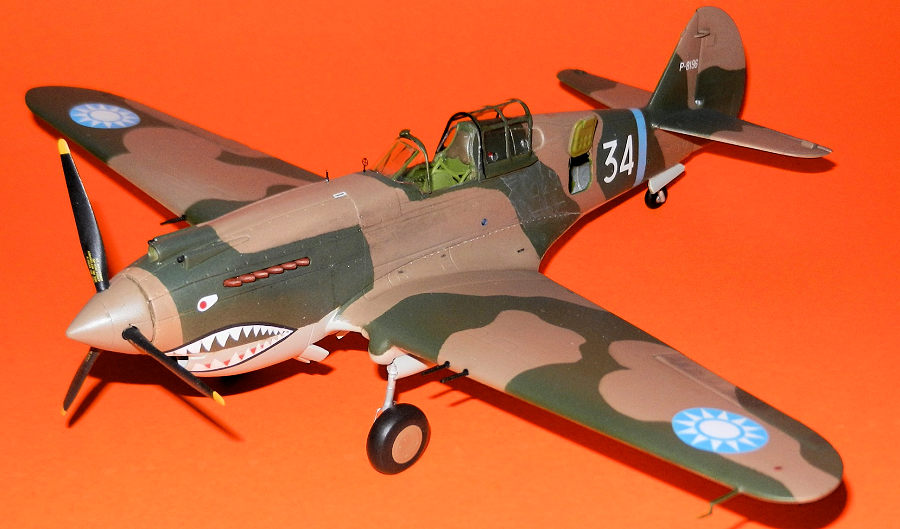
| KIT #: | A05130 |
| PRICE: | CAD$30.00 |
| DECALS: | Two options |
| REVIEWER: | Pablo Calcaterra |
| NOTES: | Cutting Edge 48255, Kits World 48058 and self made decals |

| HISTORY |
John Van Kuren Newkirk (a.k.a. Jack Scarsdale) became famous as the Squadron Leader of the Panda Bears (2nd Squadron of the AVG)
He was born in New York on October 15 1913 and when his father became an attorney at Scardsdale, NY, the family moved with him. As there was a younger cousin in the family with the same name John became “Jack Scarsdale”. On February 14, 1931 and being part of Boy Scout Troop No3 he was personally awarded the rank of Eagle Scout by no other than Rear Admiral Richard E Byrd of Antarctica fame. Jack graduated from Scarsdale High School in 1932. Inspired by his meeting with Byrd he started to study aeronautical engineering at Rensselaer Polytechnic Institute. He took to the air for the first time in the back seat of a Curtiss Falcon and after that almost hour long flight set his sights in becoming a war pilot. Taking these lessons meant that he used up all his savings and the funds put together for the 2nd year of studies. He was forced to take a job in a chemical company who wanted them to study so during the day he would work and at night take classes at Columbia. This went on for 3 years and not only one as he had expected.
Finally he was able to join the National Guard and felt more comfortable. He won a marksmanship competition but when he returned to New York someone had taken his job at the chemical company. He then joined United Airlines as a clerk. At the time his mother passed away and shortly afterwards with the help of his uncle who worked at Rensselaer he was able to go back to his aeronautics studies and complete his 2nd year. This now allowed him to join the Marines as at least 2 years of College were needed.
After passing
a month at the Floyd Bennet Field Jack was transferred to NAS Pensacola in the
fall of 1938. Here he finally learnt all the tricks of flying (barrel rolls,
Immelmann’s, stalls, etc). By Spring 1939 Jack was flying the F3F, the standard
Navy fighter. Finally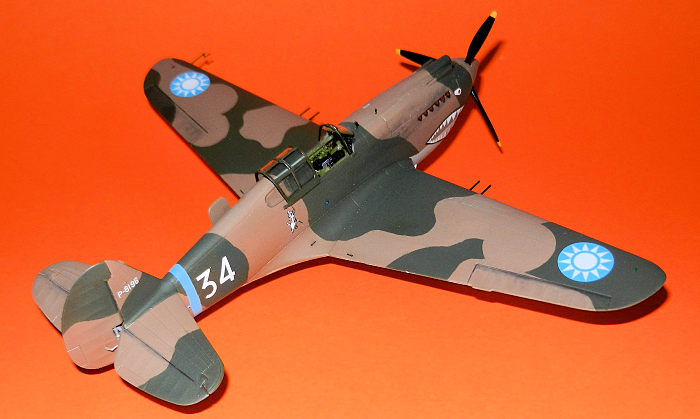 with several hundred hours under his belt Scarsdale Jack was flying the first
monoplane fighter in service in the Navy, the Brewster Buffalo. In the summer of
1939 he met Tex Hill whose English was hard to understand (“Suh, yes suh!”).
Another great friend was Bert Christman who was a consummated cartoonist.
with several hundred hours under his belt Scarsdale Jack was flying the first
monoplane fighter in service in the Navy, the Brewster Buffalo. In the summer of
1939 he met Tex Hill whose English was hard to understand (“Suh, yes suh!”).
Another great friend was Bert Christman who was a consummated cartoonist.
One day in August 1939 and during an exercise the pilots were recalled as fog started to blanket their base. Tex landed along two other pilots. Fernando Guzman, a fellow pilot born in South America, was in final to land. He was given permission to go ahead instead of diverting as they had been ordered. When about to touch down a gust of wind lifted his left wing, he overcorrected in the gloom of the fog and put his left wing into the ground. Jack could see the explosion of the plane dimly through the fog. With little fuel left and the immediate airfields also below minimums he tried to reach the airfield at Crestview. He could not find it, run out of gas and bailed out over a swamp. In darkness he landed on a fallen tree and injured his right knee. He spent the night inside his parachute. In the morning he spread his parachute on the ground in an opening leaving a note for the would-be rescuers. Using what he learnt in the Marines and Scouts he was able to survive in the hazardous environment (even killing and eating an alligator) for almost a week till his painful but steady walk took him to a place where a man was working using a John Deere tractor. He was taken to hospital with Malaria and a torn knee ligament. While the rest of the class of 1939 received their wings on November 1 1939 Newkirk had to wait a few weeks until he left the hospital to receive his.
As an Ensign (#6225) he was assigned to fly F3F and later on to F4F Wildcats from USS Yorktown’s VF-5 then stationed at Pearl Harbor. Tex and Bert were assigned to USS Saratoga and USS Ranger respectively…separated for a while.
While on Yorktown Newkirk won awards on pistol marksmanship and aerial dogfighting. After spending several weeks in training in the Caribbean USS Yorktown arrived to Hawaii where it would be based. He learned to surf the waves and also met Greg Boyington. During some flying exercises Jack’s plane was caught by an updraft and hit the canvas sleeve-target thus removing a piece of his tail. He managed to keep the plane under control and land it back on Yorktown to the great admiration of his CO.
When on leave he visited his brother in Houston, TX and met who would be his wife Jane Dunham.
On April 20 1941 (side note not relevant to the AVG but to aviation history…the day that Pat Pattle was killed over Athens) Yorktown left Pearl Harbor and after doing some neutrality patrols in the Caribbean the big ship docked in Norfolk, VA. Jack had been following the news of the war in Europe and China and was especially angered at the Japanese aggression against the Chinese.
When on leave he was approached by a Commander Rutledge Irvine (Ret’d) member of CAMCO who hired him as flight leader for a year. He was to be paid $650 a month which was considerable more than what the USN was paying. Inspired by what he had read about the Japanese Jack enlisted with CAMCO. On June 16 1941 he delivered a new Wildcat to Norfolk and then signed the papers discharging him from the Navy.
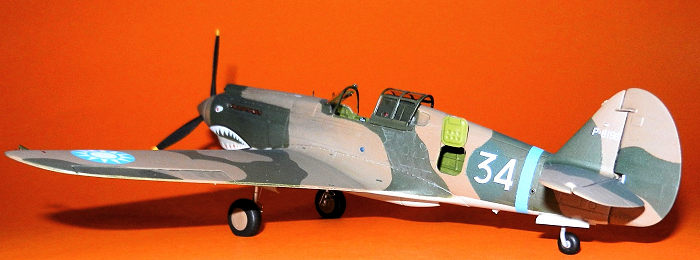 Before
leaving for China he visited his girlfriend Jane and got married on July 5, 1941
in Houston, Texas. They had a 2 night long honey moon and then they flew to San
Francisco. After spending some time together and with the other pilots and their
wives Newkirk along with Robert Sandell and the first contingent of AVG pilots
boarded the Dutch ship Jagersfontein on
July 10 1941. After one week they arrived in Honolulu and when they continued
their trip they found themselves escorted by the USS Salt
Lake City and Northampton
as apparently the Japanese had threatened to have the Dutch ship sunk before
arriving to the SEA (this seems to be a myth…why would the Japanese sink the
ship if they had not declared war to the Western powers yet?) When the Dutch
Java took over the 2 USN ships turned
back.
Before
leaving for China he visited his girlfriend Jane and got married on July 5, 1941
in Houston, Texas. They had a 2 night long honey moon and then they flew to San
Francisco. After spending some time together and with the other pilots and their
wives Newkirk along with Robert Sandell and the first contingent of AVG pilots
boarded the Dutch ship Jagersfontein on
July 10 1941. After one week they arrived in Honolulu and when they continued
their trip they found themselves escorted by the USS Salt
Lake City and Northampton
as apparently the Japanese had threatened to have the Dutch ship sunk before
arriving to the SEA (this seems to be a myth…why would the Japanese sink the
ship if they had not declared war to the Western powers yet?) When the Dutch
Java took over the 2 USN ships turned
back.
On August 11 they disembarking in Singapore. Then they met Olga Greenlaw, wife of Harvey Greenlaw the AVG Executive Officer. Finding her very attractive he told her: “The boss said you were short and fat” and other pilots chided in with praise for her beauty. Olga would later recall that Jack was a hard drinker with a behavior that was better than any of the other guys when drinking. She also remembered that the two pilots that longed to fight were Newkirk and Hill. On August 18th 1941 the three Squadron Leaders for the AVG were announced. Newkirk was given command of the 2nd and was named Deputy Group Commander in the air. He then proceeded to pick former Navy and Marines pilots for his Squadron.
When in September the first casualty of the AVG happened (an air collision in which John Anderson was killed) Newkirk led a party of men into the jungle to look for the crashed plane (and pilot). They spent the night there and had to kill two snakes with his gun that were menacing the group. In a letter to his family on October 5th he described how rags to clean the planes were hard to find as the locals would steal them to cloth their families.
On October 24th, even before the war started and after being observed by some Japanese planes the three Squadron Leaders (Sandell, Newkirk and Olson) were told by Chennault to do a recco in Thailand. They crossed the border at 20,000 ft, went as far as Chiang Mai (Thailand’s 2nd largest city), flew looking for signs of Japanese deployments and without finding anything they returned to China.
War was declared on December 8th and shortly afterwards the Hell Angel’s (3rd Squadron) was deployed to Rangoon to help the RAF. On December the 20th the Japanese decided to attack yet again Kunming. So far the attacks had been uncontested. This time the 1st and 2nd Sqn were there to protect the Chinese. Sandy Sandell led 16 P-40s while Newkirk flew 2 sections of 4 Panda Bears as back up. Though the main interception was due to be done by the Adam and Eves it was actually Newkirk’s men who saw the approaching Lily. The interception went something like this:
-“Shark Fin Blue, Bombers fifty miles east of base” (Newkirk)
-“These can’t be Japs…There is no escort!” (Gilbright)
-“ Look, you damn fool! Look at the red balls on their wings. It’s the Japs, I’m telling you!” (Christman)
-“He is right, by God! Engage, Engage!” (Newkirk)
-“I’m on ‘em” (Rector)
 They
attack out of the sun firing their 50 cal guns from too far away. After a single
pass Newkirk wiggled his wings and his men followed him to land back at their
base. Most likely they hit nothing in their single run. The 1st
Squadron performed much better and 4 bombers were shot down with the other 6
seriously damaged. The Japanese never returned to bomb Kunming while the AVG was
stationed there. Apparently Newkirk had not even taken the safety from his guns
so he had been unable to fire…Chennault was not impressed with his leaders as
they had not followed his tactical instructions…those he had tried to drill in
his men during so many weeks before the war. He said that Newkirk had had “buck
fever”: a hunter that freezes upon seeing his quarry. Newkirk and his men had a
reputation to repair…
They
attack out of the sun firing their 50 cal guns from too far away. After a single
pass Newkirk wiggled his wings and his men followed him to land back at their
base. Most likely they hit nothing in their single run. The 1st
Squadron performed much better and 4 bombers were shot down with the other 6
seriously damaged. The Japanese never returned to bomb Kunming while the AVG was
stationed there. Apparently Newkirk had not even taken the safety from his guns
so he had been unable to fire…Chennault was not impressed with his leaders as
they had not followed his tactical instructions…those he had tried to drill in
his men during so many weeks before the war. He said that Newkirk had had “buck
fever”: a hunter that freezes upon seeing his quarry. Newkirk and his men had a
reputation to repair…
After some very intense battles and with a diminishing number of planes and pilots 18 Panda Bears (as the 2nd Squadron was known) flew south to relieve the 3rd Squadron. Newkirk would send daily reports to Kunming updating battles and situation. After 3 days of lack of action except for some false alarms Newkirk, who lead from the air contrary to Oley Olson in the 3rd Squadron, took the war to the Japanese. After receiving the orders from the just arrived Air Vice Marshal RAF Stevenson Newkirk exclaimed “Let’s take the war to the enemy!” and took off on January 3rd 1942 leading Tex Hill, Jim Howard and Bert Christman (who was forced to return with a bad engine). They flew beyond their target and then attacked Tak (Raheng for the Japanese) with the rising sun on their backs. At that moment the Nates had just returned from a raid on Moulmein and there even was a crowd celebrating their successful return. Three Nates were on the ground, three more about to touch down. Focused on those enemies below Hill suddenly realized that their flight had been joined by another three planes: Nates! One latched on to Howard and was systematically damaging the Flying Tiger while Howard continued his run to attack a plane that had just landed Hill turned and shot down the plane attacking Howard. Then reversed his direction and shot at another Nate head one claiming it as shot down but in fact it had been Newkirk who also claimed this Nate for his 2nd kill of the mission. Hill’s plane had been hit 33 times by a Japanese plane he had not seen. A bullet hit his propeller when he shot at the Nate head on. The resulting out of balance propeller made the engine vibrate terribly to a point that Hill thought the engine would come out of his P-40. Howard came down for a 2nd attack on the airfield while the party celebrating was rushing everywhere. He destroyed another plane on the ground and then was hit by flak. With this propeller dead he started to look for a place to do a forced landing but suddenly the Allison came back to life. Howard’s plane had been hit 11 times. The three Panda Bears returned safely to their base where they claimed 4 destroyed on the ground and 3 shot down. Japanese records only show 2 damaged on the ground and 1 shot down. Some consider this the first offensive action of the US Forces in WWII (though technically the AVG was not part of the US Armed Forces…)
Hungry for good news from the war Newkirk and his teams exploits started to fill pages in the media. He was described as The Scourge of Burma, The Scorpion of Scarsdale and even Danger (which was his own given nickname).
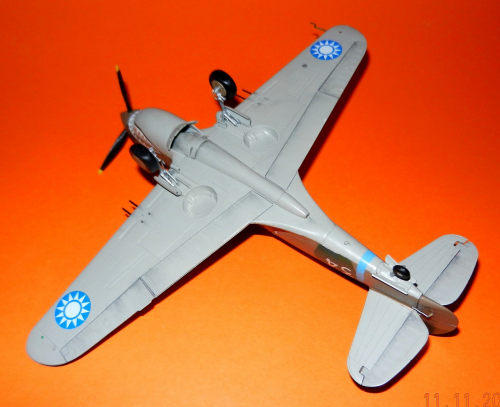 On
January 8th
Newkirk led his men again on yet another raid against Japanese airfields though
this time 67th
Sqn RAF also sent 6 Buffaloes.
Again Tak was the target and 7 P-40s flew in a single line with weavers to
protect them from a surprise attack. As planned the first section dove out of
the sun, the second from the southwest and the third from the northwest. After
diving for the first time and seeing nothing but the Ops building Newkirk
attacked again and this time he was able to identify a silver plane that he left
on fire. A truck driving in the area was also hit by Scarsdale and it slammed
into the burning Nate. Finally he hit a 2nd
plane that collapsed when he felt a couple of “plunks” in his fuselage. These
were hits by rifle bullets as the Japanese soldiers were firing back at the
attackers. They were dispersed by the machine guns of John Petach. There was a
significant lack of targets and most pilots claimed damaging or destroying a
single target each. When they landed back at Mingaladon at 6.30 PM they
congratulated themselves and even Newkirk was slapped on the back by the RAF
duty officer who exclaimed: ”Good show!” Though they were credited with 3 planes
destroyed the actual tally was one destroyed, one damaged and a starter truck
destroyed.
On
January 8th
Newkirk led his men again on yet another raid against Japanese airfields though
this time 67th
Sqn RAF also sent 6 Buffaloes.
Again Tak was the target and 7 P-40s flew in a single line with weavers to
protect them from a surprise attack. As planned the first section dove out of
the sun, the second from the southwest and the third from the northwest. After
diving for the first time and seeing nothing but the Ops building Newkirk
attacked again and this time he was able to identify a silver plane that he left
on fire. A truck driving in the area was also hit by Scarsdale and it slammed
into the burning Nate. Finally he hit a 2nd
plane that collapsed when he felt a couple of “plunks” in his fuselage. These
were hits by rifle bullets as the Japanese soldiers were firing back at the
attackers. They were dispersed by the machine guns of John Petach. There was a
significant lack of targets and most pilots claimed damaging or destroying a
single target each. When they landed back at Mingaladon at 6.30 PM they
congratulated themselves and even Newkirk was slapped on the back by the RAF
duty officer who exclaimed: ”Good show!” Though they were credited with 3 planes
destroyed the actual tally was one destroyed, one damaged and a starter truck
destroyed.
January 20th saw a different type of attack by the Allies: 6 RAF Blenheim were escorted by a mix formation of 6 P-40s of the Panda Bears and the recently arrived Adam and Eves led by Newkirk (Moss, Neale, Bartling, Christman and Geselbracht). In a valley at the border they found some Nates and combat ensued. Newkirk claimed two (becoming an ace) Neale another one and Moose Moss the 4th plane before being shot down. Christman returned with his plane full of Japanese lead. In the meantime the Blenheims were able to have a clean run to the target and they bombed Mae Sot in a shallow dive from 2,700 ft.
On January 22nd Stevenson sent his planes to attack a Japanese party that was supposedly landing at Mae Seriang in Thailand. The 6 Blenheims and 11 Tomahaws found nothing in bad weather. According the Newkirk the bombers missed the town and the bombs scattered to the west of it and in some fields. The P-40s then proceeded to strafe the town and airfield but found nothing.
The following day and after yet another air engagement the Flying Tigers were chatting and being photographed by LIFE magazine when the alarm was given. Another raid by the Japanese was coming. Newkirk and 8 more P-40s plus 3 Buffaloes took off to intercept them. The Ann bombers had missed their escort in bad weather and arrived over Mingaladon alone. Newkirk later on said that they attacked the bombers from multiple directions at the same time. He had picked one that fell 75 ft only to regain control and return to the formation. He saw on Ann falling close to Johnnie Walker (the “satellite airfield”). Then finally the escorting Nates arrived and a fighter versus fighter combat started. After being singled out by two Nates and managing to evade them at 3,000 ft Newkirk climbed back and caught with one using his war emergency power. “After one burst his wing came off and he went down. Another bunch of fighters had been shooting at me while I fired on that one. My engine cut out and heated up and lost power, so I returned to the field where I crashed due to the fact that my flaps would not come down” he later recalled. His friend Bert Christmas was shot down, bailed out from his plane and apparently was shot thru the neck while floating in his parachute. Like in many combats there was a massive over claim on both sides. The Japanese claimed 7 (actual losses were Christman, a Buffalo and Newkirk’s damaged plane). The Allies claimed 11 plus one by the RAF. Actual Japanese losses were one Ann shot down and 10 more damaged in this combat in the afternoon.
Though they were steadily losing planes Newkirk refused to be reinforced. Nevertheless Chennault sent 12 more P-40s from the 1st Squadron.
After yet another combat on the 28th Newkirk wrote that “The planes that we have here now are beginning to look like patchwork quilts for the holes it hem. The engines are also getting tired…There are not sufficient ground crews for the job and there is not enough time to for them to teach the Chinese or other helpers which they steal from our neighbors (the RAF). (…) I am firmly convinced that the AVG does not need anything except cooperation from the army or any other organization, as far as we are concerned”.
As more fighters were starting to arrive from Africa in early February there was talk of lending some Hurricanes to the AVG. To this effect Newkirk checked out in a Hurricane…but when the 18 Hawker fighters that would reinforce the Allies crashed during their inbound trip after losing their guide the project was put on hold…
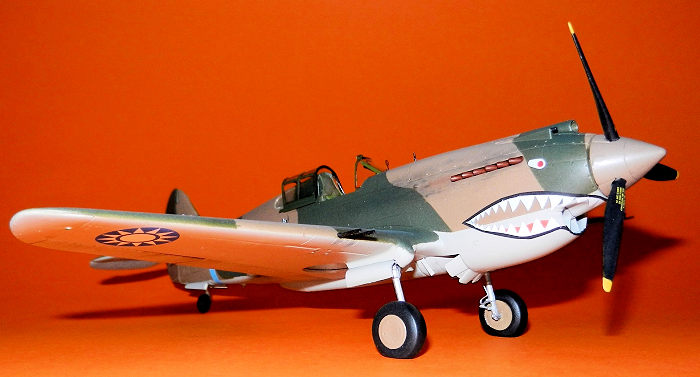 At
that time Sandy Sandell died in a crash when testing his “repaired” fighter. The
Panda Bears started to retreat North with Newkirk being the last to leave South
Burma around February 7th
for Kunming. Apparently he was still full of action and tried to delay his
return north as much as possible. He made in to Kunming on February 14th
thinner than ever and with some grey hair. He told Olga that “It was no picnic.
But it was a lot of fun”.
At
that time Sandy Sandell died in a crash when testing his “repaired” fighter. The
Panda Bears started to retreat North with Newkirk being the last to leave South
Burma around February 7th
for Kunming. Apparently he was still full of action and tried to delay his
return north as much as possible. He made in to Kunming on February 14th
thinner than ever and with some grey hair. He told Olga that “It was no picnic.
But it was a lot of fun”.
On February 28 the AVG were guests of honour of the Chiangs and the pilots were dressed in their best. Life Magazine Vol 12, No 13 (March 30 1942) had an article on the Tigers and Newkirk claiming he had shot down 25 (!) Japanese planes.
On March 21st Chennault ordered a reprisal attack to be flown from the AVG base at Kunming. The best 10 pilots were picked. They were to split into two teams in order to attack 2 airfields in Thailand: 6 Adam and Eves led by Neale to Chiang Mai and 4 Panda Bears (led by Jack Newkirk) to the other one at Lamphum. Stationed in an advanced tiny RAF airfield closer to the border the night before the complex raid Newkirk was unwell. It seemed he had a premonition he was not coming back as he commented that “After tomorrow, I think it won’t make any difference” when he was told that he should refrain from brushing his teeth as the water was contaminated. After taking off early the following day Newkirk did not follow the attack plan and flew straight to their target. But instead of going after the airfield he strafed the Chiang Mai train station, then finally flew on to Lamphun where he attacked some barracks and then they took a look at some auxiliary fields finding nothing there either. Finally they turned north probably with the intention of joining the other 6 P-40s. Newkirk made a turn over Lamphun coming from the southeast, stayed east of the railroad and the river and when it reached the railroad bridge at the northern end of the town the Japanese gunners that were protecting it started to fire at the Tomahawk. When this happened the plane started a wide turn to the west and then continued to the south again crossing the town. When Newkirk and his wingmen reached the southern end of Lamphun he turned east again and crossed over the Kuang River. He fired his guns at an oxcart killing the man and the ox (his wingmen wrongly identified it as an armoured car). The plane continued towards a field that was in front of a Buddhist temple. We now know by witnesses on the ground that the plane hit a tree with a wing and disintegrated in a ball of fire with the engine landing 300 yards further away. At first Keaton and Geselbratch did not understand what had caused the ball of fire but then it dawned on them that their leader had finally bought it. We will never know if he had been hit by the Japanese gunners and was trying to crash land on the field, crashed because of target fixation or did not see the tree and run into it. Jack Scarsdale Newkirk was found out of the plane with his parachute partially deployed and was buried at the edge of the forest. The remains of the plane were taken by the Japanese and shown at the Police station. His friend Tex Hill replaced him as leader of the 2nd Sqn a few days later.
His official score was 10.5 Japanese planes and he received the British DFC (posthumously) and the Chinese Cloud Banner.
He was taken to the US and buried in the yard of the Protestant Episcopal Church of St James the Less on May 1 1949. His inscription read “Until I have done all in my power I shall not return”. This is something very similar to what he wrote to his wife when the action was starting: “I can’t leave until this job is finished”.
Hats off to John Newkirk!
| THE KIT |
Reviewed by your editor a while back the Airfix kit is a pleasure to build. Fit of the parts is excellent, engineering is great, and the cockpit is almost a kit in itself with just plastic parts that properly represent that part of the airplane for the first time. Yes, there are some ejector marks in odd places but nothing that you cannot fix with 30 seconds of sanding.
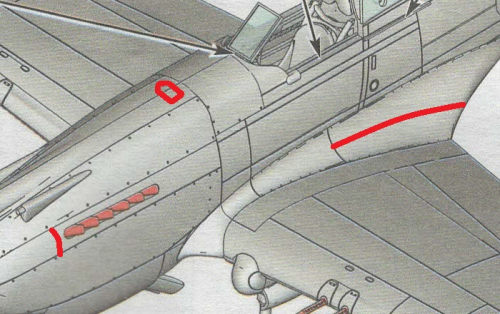 Other
areas where the kits falls short but are easy to fix: the actuator rod on
top of the rudder is only present on the left side. The kit’s is incomplete
and has the same “actuator” molded on the right side of the rudder. Finally
the support and cable sticking out of the rudder below the horizontal
surfaces on the right side are also missing.
Other
areas where the kits falls short but are easy to fix: the actuator rod on
top of the rudder is only present on the left side. The kit’s is incomplete
and has the same “actuator” molded on the right side of the rudder. Finally
the support and cable sticking out of the rudder below the horizontal
surfaces on the right side are also missing.
My only criticism is the lack of some panel lines (including the prominent landing light under the wing) and the fact that the decals, though complete with lots of stencils and details, have an 11 point start (instead of 12) and that the Chinese blue is not accurate and seems to have a “violet” hue.
Issues with the nun-hat? The line of thrust is a little bit low? Nothing that will detract from a great replica. I mean…no matter how perfect the kit is…it will still have a fatal flaw: it won’t be able to fly. So it won’t be 100% accurate anyways…For my standards it is great.
| CONSTRUCTION |
As I said the cockpit is great. The only missing part is the light for the reflector gunsight on the floor ahead of the control stick. I also added some photo etched lap belts.
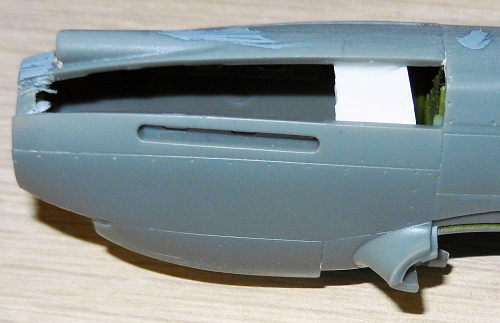 The
assembly of wings and fuselage are as easy as they can get. Maybe the curved
panels covering the union of fuselage to wings are a little bit tricky to
attach and if you don’t positon them perfectly then a gap in the union to
the wings might show up…I know it because I had to use some liquid corrector
to fix my right wing/fuselage union… Another issue that I found with this
kit is that the propeller hub leaves a gap around the propeller blades. I
filled these with putty and carefully sanded them. I had to support the
fuselage gun covers with some plastic card from inside. Rudder was left
aside and the tail horizontal surfaces were glued on a slightly drooped
position.
The
assembly of wings and fuselage are as easy as they can get. Maybe the curved
panels covering the union of fuselage to wings are a little bit tricky to
attach and if you don’t positon them perfectly then a gap in the union to
the wings might show up…I know it because I had to use some liquid corrector
to fix my right wing/fuselage union… Another issue that I found with this
kit is that the propeller hub leaves a gap around the propeller blades. I
filled these with putty and carefully sanded them. I had to support the
fuselage gun covers with some plastic card from inside. Rudder was left
aside and the tail horizontal surfaces were glued on a slightly drooped
position.
I decided to open the holes in the exhausts. Using a pin to mark the center of each exhaust I then placed the drill bit carefully on that pin hole. Then with low speed I made a hole on each exhaust. I left them aside for the final part of the construction. Once the kit was put together (minus the landing gear) it was time to paint it.
| COLORS & MARKINGS |
I used scale plans from Tullis’ book to make a template of the cammo pattern. A coat of white ModelMaster Primer was used to check for any imperfection. The undersides were painted with ModelMaster Acryl 4693 which is an excellent match of the original colour. Then this was masked and I painted the light brown (ModelMaster Acryl 4709) including the wheel hubs. Once dried, I barely sprayed a very light and much diluted coat of Sand (ModelMaster Acryl 4711) as the pilots described a faded out cammo especially on the wings, tail and fuselage spine (not so much on the fuselage halves)
Then it was time to mask the brown using the template mentioned above cut in Tamiya tape. The green (ModelMaster Acryl 4726) was applied followed by a very diluted and light coat of a darker shade of green (ModelMaster Acryl 4729) as the green turned a darker/bluish tone when exposed to the sun.
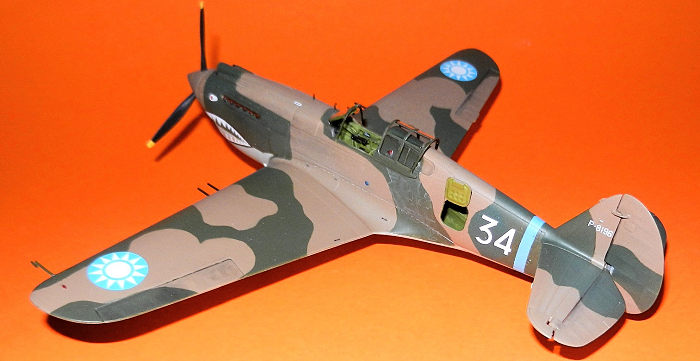 “34”
had apparently a different number painted on the fuselage at some point and
it seems that the area underneath it was a fresher darker green. I masked
these “somehow rounded” areas and sprayed them with MM 4729 straight from
the bottle. In hindsight the overpainted area on the left hand side of the
fuselage should have been larger or placed further back (maybe just under
the “4”).
“34”
had apparently a different number painted on the fuselage at some point and
it seems that the area underneath it was a fresher darker green. I masked
these “somehow rounded” areas and sprayed them with MM 4729 straight from
the bottle. In hindsight the overpainted area on the left hand side of the
fuselage should have been larger or placed further back (maybe just under
the “4”).
I then realized that I had not painted the fuselage ID band (light blue made with a mix of white and blue). With masking tape I cut the ID band, put it in place, and then masked the areas around it very tightly. Then I removed the ID band made with tape thus exposing the area to be painted and I proceeded to airbrush it.
Propeller is black with yellow tips. I used a thin black pencil to highlight the moveable surfaces and my typical sanded black pastels to give them a little bit of dirt. Same method was used for the machine guns and exhaust stains.
All formation lights were first given a drop silver (the excellent Vallejo paints) and then a drop of Future with a touch of blue (fuselage) or clear red or blue for the wings. White was used for the ones on the tail. A large drop of Vallejo silver was spread in circular motion to create the landing light under the wing.
The caps behind the pilot were painted in red and aluminum. Another tricky part was to simulate the dirty pattern created by the overflowing fuel below these caps. For this I used water with a drop of white and then put a tiny amount of this mixture on the fuselage blowing it downwards. It was repeated several times until it looked dirty enough with a help of a damped Q tip. Exhausts were painted using Rust colour and the openings black. The kit was given a coat of Future and was ready for the decals.
Having left the Airfix stencils for my son’s Monogram kit (Olson’s “68”) I created my own using Powerpoint and clear decal paper (No step, Fuel). I finally found a way around for the “Prestone” and made several copies on white decal paper. One was added to the top of the nose and the others retrofitted to the other AVG kits I had already built.
The main shortcomings I had in terms of decals were the “34” and the shark mouth. I thought that the mouth supplied by Kits at War was perfect but upon a close inspection of the profile in Clement’s book I found that the teeth and tongue should be smaller. For the “3”s I used “8”s (for the bottom half) and “7”s (for the top half) to properly represent the type of font used in this plane. The “4”s were slightly adjusted but worked much better.
For the teeth I had to work a little bit harder: cut the larger teeth smaller and also cut out the tongue where needed. Precision and slow cutting with a new blade on the Xacto knife. The stencils on the propeller blades are from the Airfix kit. Tail numbers are from Kits at War. I used some light blue roundels for the top of the wings and the darker ones for the bottom of the wings (from Cutting Edge). Almost the last touch was “top hat wearing and drunken” Panda Bear designed by his good friend Bert Christman (from Kits at War). All decals reacted perfectly to Set and Sol solutions.
| FINAL CONSTRUCTION |
With a kit as complete as
this one the final details were few. These include attaching the rudder
slightly offset, gluing the fuselage acc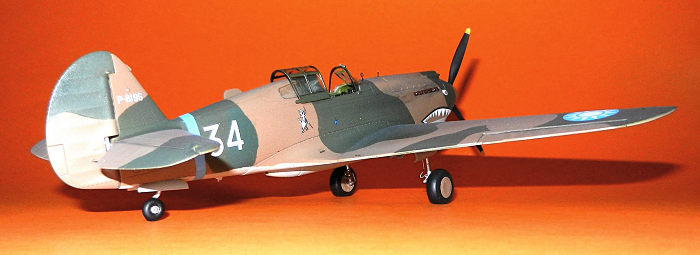 ess
door open with some thin plastic strings painted in green to represent the
supporting arms, photoetched gunsight, the brake lines running down the
landing gear (very thin wire painted in aluminum), the horn on the tail (for
the rudder), pitot and a little actuator under the right side of the tail.
ess
door open with some thin plastic strings painted in green to represent the
supporting arms, photoetched gunsight, the brake lines running down the
landing gear (very thin wire painted in aluminum), the horn on the tail (for
the rudder), pitot and a little actuator under the right side of the tail.
The on-the-field designed reflector gunsight was made up with clear plastic cut to shape following the pictures found in Larry Pistole’s book. I attached it to the armoured glass, glued the windshield and the two windows behind the cockpit and finally sat the hood in place. Then I realized I had sanded off the rear mirror by mistake so I scratchbuilt one using evergreen, glued it to the top of the windshield frame and painted it with green (cammo) and silver (“mirror” itself).
| CONCLUSIONS |
A great kit. Won’t ever consider buying any of the older P-40Bs in the market even if they were 5 bucks. Hands down, the best P-40B out there…IMO!
| REFERENCES |
AVG Colours and Markings by Terrill Clements (Osprey)
Flying Tigers by Daniel Ford
The Old Man and the Harley by J. Newkirk
The Lady and the Tigers by Olga Greenlaw
Tigers over China by T. Tullis
Wikipedia
November 2018
Copyright ModelingMadness.com
If you would like your product reviewed fairly and quickly, please contact the editor or see other details in the Note to Contributors.